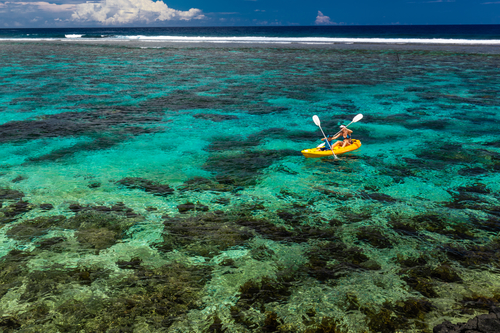Whether you are a novice kayaker or an experienced paddler, sea kayaking in the Barrier Reef in Belize is an experience you will not want to miss. The Belize Barrier Reef, the atolls-(Glover’s Reef, Turneffe Atoll and Lighthouse Reef), the shallow inshore waters combined with a string of small and closely spread islands-(cayes), make this place among the best destinations in the world for sea kayaking.
Belize has thousands of untouched coral reefs which are home to numerous and various aquatic life, crystal clear waters and inhabited remote tropical islands, creating a perfect opportunity to explore and tour the protected waters by a kayak.
Kayaking in Belize is a fantastic experience especially when the trade winds blow that makes your kayak more responsive and lighter. You can also dive into the waters for snorkeling to explore the vibrant and colorful marine life.
Sea kayaking also helps in connecting with the local lobster and conch divers who make their living from the sea of which many of them still use dugouts and small boats.
The Belize Barrier Reef
The Belize Barrier Reef extends 180 miles off the shore of Belize mainland and is considered as the most diverse segment of the Mesoamerican Barrier Reef System and the largest in the western hemisphere on second to Australia’s Great Barrier Reef in the world.
It is unrivaled for sea kayaking along with snorkeling and scuba diving, with a spectacular diversity of coral reefs and over 500 species of invertebrates and fish. Behind the corals are small islands-(cayes) of coral sand on which mangroves thrive.
The submerged mangrove roots trap sediments that provide habitat to a wide array of seabirds, marine invertebrates, and juvenile fish.
The Belize Barrier Reef also has three distinct Caribbean atolls.
Glover’s Reef Atoll
The Glover’s Reef is among the rich marine environments in the Caribbean Sea. It is named after John Glover, a 17th-century pirate that used this region as a base from which he would attack Spanish merchant ships and rob them of their riches.
Today, the protected marine reserve is famous for its abundance of marine life and phenomenal clear turquoise waters. Glover’s Reef is an elliptically shaped reef located about 40 miles off the shore of Belize’s mainland and measures 20 miles in length and 7 miles in width.
There is a shallow lagoon within Glover’s reef with over 700 patch reef. The reef wall steeply drops 2600 feet to the floor of the sea about a mile from the eastern perimeter of the atoll.
Where the open waters of the Caribbean Sea meet the sheltered lagoon is a profusion of marine life which is unmatched for sea kayaking along with snorkeling and diving.
Lighthouse Reef Atoll
Lighthouse Reef is the most remote of the three atolls and remains unspoiled and wild. The coral reefs in the atoll’s lagoon are home to a staggering 200 species of fish with various reef types like ledges, drop-offs, shelves, and shallow reefs.
Lighthouse Reef is also home to two marine parks, underwater marine trails and six islands (cayes). At the center of Lighthouse Reef is Half Moon Caye- 45 acres of beaches, coconut palms, a rare littoral forest, and shelters a large colony of red-footed boobies. Half Moon Caye is now the site for sea kayaking, island expeditions, and snorkeling.
Turneffe Atoll
Turneffe Atoll features great plant and animal life. The atoll is encircled by beautiful and well-developed coral reefs and is home to over 25 species of birds. The surrounding habitat is a favorite feeding and resting ground for dolphins.
Coral gardens within the atoll in the protected waters can be easily accessed by a kayak not far away from the shoreline.You can also paddle to different parts of the atoll to take a look at the atoll’s resident dolphins, uninhabited cayes, and explore mangrove creeks.
The Barrier Reef in Belize is a great and safe destination for experienced kayakers to explore endless mangrove-covered islands and dive to take a peek at the world’s second largest barrier reef on their own.
However, less experienced paddlers should hook themselves with local guides that are more conversant with the land sea. You will also get a chance to learn the local culture and try out traditional cuisines. It’s also the perfect spot to bring along family and friends.

